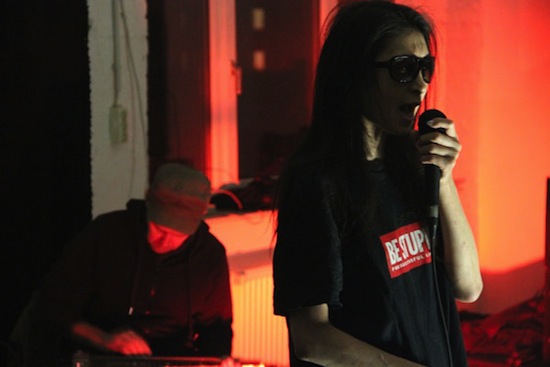London’s magnificent Café Oto has been intimately linked with Japanese underground and experimental music since the venue opened, as seen in everything from its regular residencies of Japanese artists such as Otomo Yoshihide and Keiji Haino to the name itself; Oto means sound/noise in Japanese.
This fruitful relationship currently shows no sign of abating, as attested to by this week’s concert featuring three acts from, in Oto’s words, ‘the Japanese underground’: regular Hijokaidan vocalist Junko with the French guitarist Michel Henritzi; Improv guitarist Shinichi Isohata; and solo piano accordionist À Qui Avec Gabriel.
The concert was especially well put together in terms of balance and pace. Each act provided productive contrast to the previous one, both in terms of sonic palette and level of intensity, which increased from the intimate accordion beginnings to the scrawled missives of the second act, before exploding into full-on wall noise with the Junko finale.
À Qui Avec Gabriel (Aki being the performer’s name, and Gabriel being the name of her instrument) opened the concert with delicacy and some grace. The performance nuzzled closely with the atmosphere in the room, where the sun was going down on a lovely early-summer Oto evening and patterns were projected onto the darkening walls through a gauze-covered lantern. À Qui’s style is eclectic, taking in everything from medieval dance forms to European-sounding folk airs, and variously-Japanese musical signifiers to skitters, breaths and silences straight from the lexicon of experimental music. Her 2010 album Itsukushimi No Ame No Naka De incorporates all of these elements, and it was no different this evening, with the opening, spare and perforated blues number outlining a typical progression from barely-there high register gestures to more sketched-in harmonies and melodies sitting closer to the bottom of the keyboard. This was followed by a Japanese-redolent number full of semitones and reedy echoes, and a more major-key trot after that. The set climaxed in intensity with the wheezing dances of the fourth number, in which the performance came closest to the kinds of sonic meditations and meanderings to which Oto is so used, before a dark-hued final number brought a lovely, warm performance to a close.
After this comparatively serene opening, the discursive, wide-scoped performance of guitarist Isohata ratcheted up the volume and intensity levels. Like the accordionist before him, Isohata’s performance was stylistically eclectic. Beginning with some leisurely, Bailey-like jagged explorations of his instrument, Isohata moved through a wide array of sounds and moods, adding small implements to the strings to create percussive sounds, playing the strings with metal, and speeding through flurries of notes. Most effective were two sections in which the guitarist bowed strings continuously whilst his left-hand sounded rising harmonic sequences, in the first place of minor chords with low strings bowed, and in the second of a minor-to-relative-major sequence with high strings bowed. On the whole, though, this sort of virtuosity, whilst impressive and exciting, came second to the wonderfully thoughtful, exploratory feel of Isohata’s approach, where a kind of tinkering experimental spirit ruled.
As noted above the atmosphere in the room on the evening of the concert was magic hour lovely. And whilst Isohata certainly played at higher volumes than À Qui, you’d be forgiven for remaining in the loll and lull established in the early stages of the show. That is certainly what myself and my companion did, to the point that I, for one, was almost completely oblivious to what was to come when I went to take my seat for the headlining performance. Not for long; suddenly, guitarist Henritzi was scratching out huge minor and chromatic distorted pitch clouds on the guitar on his lap, whilst Junko was emitting her characteristic wraith death-wail, screaming out words and sounds as if language was leaving her. Amidst this melee, Henritzi would periodically switch on an extra distortion pedal, its output at full, utterly shattering any sense of restraint or politesse in doing so. It is often said that hearing is touch at a distance, and this performance, like so many great noise performances, closed down that distance vividly; experiencing the 15 or so minutes of this sonic onslaught felt like being scrawled all over by insects. It was fabulous. If anything, following the first short dimming of the sound before what turned out to be the final wall-climax, I could have done with five or ten minutes more. However, it would be churlish to complain after hearing such a rip-roaring finale, especially in the context of what was, overall, an exciting and fascinating show.


